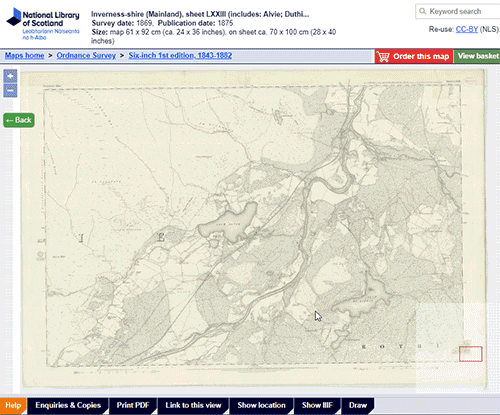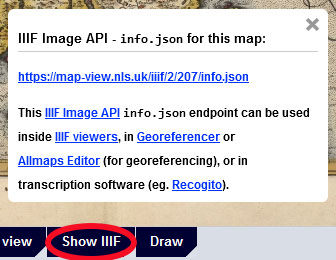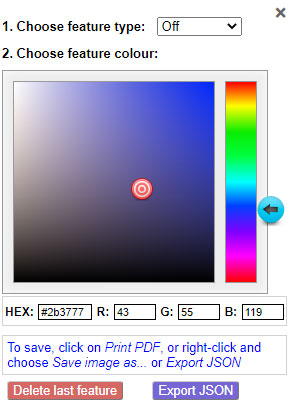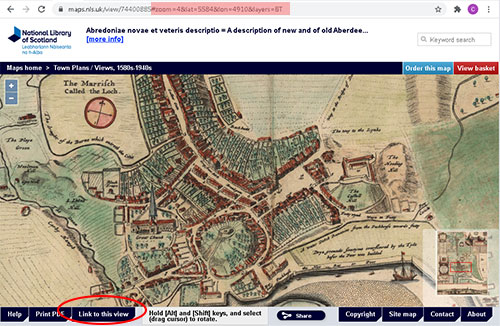Help - Map Images viewer
This Map Images viewer allows you to explore all of our map images in detail. With the viewer you can zoom, pan or rotate the map.
You can download a PDF of any part of the map, as well as save and copy links to the map or to specific parts of it. For series maps, it is also possible to view the location of the map, or view the map as a georeferenced layer.
You can draw, edit or delete features and also save the results as an image or JSON file.
To zoom in:
- Double-click with the mouse / Double-tap on a touch screen.
- Pinch-to-zoom on a touch screen
- Use the mouse wheel (if available).
- Hold down the 'shift' key and drag the cursor to draw a specific rectangle to zoom in to.
To move sideways or pan:
- Drag the image in the main image view.
To rotate:
- Hold the [Alt] and [Shift] keys down, and drag with your cursor to rotate the map. Click on the blue arrow to the upper right, or refresh the page to return to the default rotation.
- Pinch with two fingers on a touch screen to rotate the map. Tap on the blue arrow to the upper right to return to the default rotation.
To print / capture screen image
- By default, choosing the 'Print' option / Ctrl + P in most web browsers will result in the current map view extending across your default page for printing or saving what you can see on screen.
- Click on the Download PDF tab to the lower left, and it will download a default A3 landscape PDF of your current map view.
- Tap the More... button (lower left), and then tap on the Link to this page to see the URL of the page you are looking at. You can also copy this to the clipboard.
- If you require a print of a large map in detail, or of an area larger than your screen in detail, then you will need to Order this map.
Further information is available on printouts, images and photocopies on our Enquiries & Copies page, as well as on How to order map copies.
Full-screen view
This displays the zoomable image without the header and footer.
To link to the page or specific view
- Tap the More... button (lower left), and then tap on the Link to this page link to view the URL of the page (and part of the map) you are looking at.
- A suffix will be added to the standard URL (ie.
maps.nls.uk/view/[map ID]). This includeszoom=,lat=andlon=parameters to link to a specific part of the map. - You can also copy this to the clipboard.
 To link to the page or specific view
To link to the page or specific view
- By default, the standard URL for each map (ie.
maps.nls.uk/view/[map ID]) presents the initial view of the whole map on the screen.
To save or send a link to a more specific part of the map, zoom and pan to the area you are interested in, then select the Link to this view tab (circled in red below). A suffix will be added to the standard URL. This includes zoom=, lat= and lon= parameters (highlighted in pink below in the address bar) which relate to the original image and pixel dimensions. If you copy this longer URL, it will link to the specific part of the map - useful for saving or sharing a link to this specific part of the map.
Please note that if you are using an iPad, you will need to also tap the address bar for this longer URL to be visible.
Show location
When viewing a series map, click on the Show location tab in the footer, to bring up options to view its real-world location:

When viewing a series map, tap on the More... button (lower left) and then choose your option:
- Select Show map location if you want to see the location of this map in the Map Finder viewer.

The Map Finder viewer will then open, showing the location of the map, with its outlines/extents highlighted along with maps from the same series. This is useful for showing the outlines of the map in their real-world location, allowing you to also view other maps covering the same place, or adjacent maps. - Select View georeferenced location to click on the map and view its location in the Georeferenced Maps viewer.

The Georeferenced Maps viewer will then open, showing the georeferenced layer the map is from, centred on the place you have clicked on. This is useful for showing the map you have been looking at in its real-world location, so you can compare it with other georeferenced layers.
Show IIIF

This shows the IIIF Image API base URI or info.json for the specific image. This identifier includes details about the specific image, including its width and height in pixels, image format, and the way it is tiled, allowing the image to be easily re-used in other applications. For example, you can copy this info.json URI into other viewers such as Georeferencer or the AllMaps Editor (to georeference the image), or into transcription software such as Recogito to record and share annotations. See Awesome - IIIF for a more complete list of tools, resources, and demos using IIIF.
The International Image Interoperability Framework (IIIF) is a group of standard APIs intended to support the sharing and reuse of media.
Drawing Features

If you select Draw, it will display a dialogue box on the right with options to draw features, select a colour, edit or delete features and also save the results as an image or JSON file:
- Choose a feature type to draw with - a point, line, polygon or circle.
- Choose the colour of the feature you want to add. By default this is dark blue. You can click on the colour chart or type numbers into the HEX or R,G,B boxes below. For each feature you choose to draw, you can specify a different colour.
- Once you have drawn a feature, you can move it by moving your cursor over the feature and dragging it. It is also possible to delete the last feature you have drawn by selecting the Delete last feature button.
- To save the image as a PDF, select Print PDF to the lower left and a PDF will be generated including the features you have drawn. You can also right-click on the map image and choose "Save Image As" to save just the current map view as a .png image. You can also export the features you have drawn as a JSON (Javascript Object Notation) file by selecting Export JSON. The JSON file can be easily edited with a text editor, and it has details of the features you have drawn and their pixel locations. X and Y coordinates of pixel locations are given from the upper left-hand side.
If you wish to trace georeferenced images, so that the features you trace can be overlaid on the real world or used in geographic information software, then please use the Georeferenced Maps - Full Screen/Draw viewer.
Compatible browsers
This viewer is a customised version of the open source IIIF Image API Viewer for OpenLayers 6, and is compatible with all modern standards-compliant web browsers. Viewing but not printing is also possible in Internet Explorer 9.
Please email us if you have any queries about this viewer.



